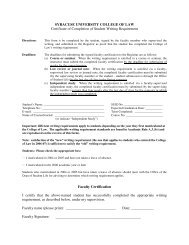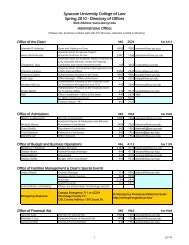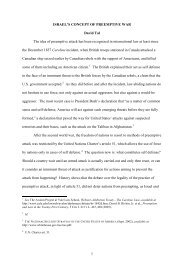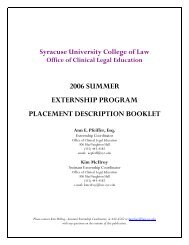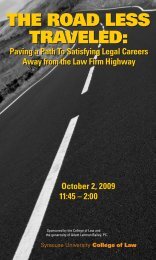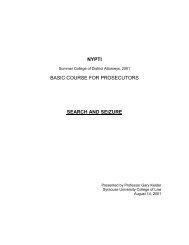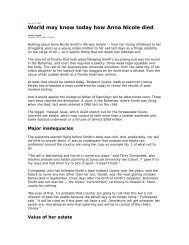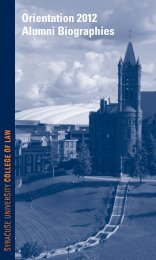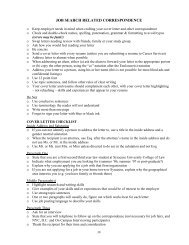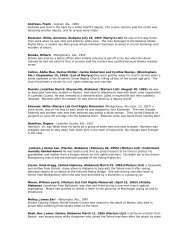2011 Conference Program (PDF) - Syracuse University College of Law
2011 Conference Program (PDF) - Syracuse University College of Law
2011 Conference Program (PDF) - Syracuse University College of Law
Create successful ePaper yourself
Turn your PDF publications into a flip-book with our unique Google optimized e-Paper software.
4.6 The Frontiers <strong>of</strong> Sexual Orientation <strong>Law</strong><br />
political and social reactions to the Civil Rights era. The Article develops this proposition<br />
by explaining how this cultural reaction played out legally in the criminal justice<br />
system—how political and public wrath expressed itself through the mechanics <strong>of</strong><br />
ritual—the way lynching did for a previous age.<br />
Heron Greenesmith<br />
Drawing Bisexuality Back into the Picture: How Bisexuality Fits into LGBT Legal<br />
Strategy 10 Years After Bisexual Erasure<br />
Written on the tenth anniversary <strong>of</strong> Kenji Yoshino's seminal piece, Heron Greenesmith's<br />
article begins from the position that bisexuality is invisible in legal culture and poses two<br />
hypotheses for this invisibility. First, while Yoshino's analysis retains viability when<br />
analogized to the legal context, Greenesmith proposes that bisexuality is inherently<br />
invisible to the law, beyond the reach <strong>of</strong> deliberate erasure. That is, where sexuality is at<br />
issue, plaintiffs are presumed monosexual, and must either declare their own bisexuality<br />
or have it found for them. Second, Greenesmith argues that where bisexuality is legally<br />
relevant it has been erased within the legal culture because it is complicated—because it<br />
muddles legal arguments that depend upon the binary <strong>of</strong> sexuality. Greenesmith uses the<br />
suspect class analysis to show how bisexuality complicates legal arguments, and proposes<br />
two solutions through which bisexually can be introduced into the Equal Protection<br />
analysis without compromising sexual orientation's suspect classification.<br />
Ann Tweedy<br />
Polyamory as a Sexual Orientation<br />
This article examines, from a theoretical standpoint, the possibility <strong>of</strong> expanding the<br />
definition <strong>of</strong> sexual orientation in employment discrimination statutes to include other<br />
disfavored sexual preferences, specifically polyamory. It first looks at the fact that the<br />
current definition <strong>of</strong> sexual orientation is very narrow, being limited to orientations based<br />
on the sex <strong>of</strong> those to whom one is attracted, and explores some <strong>of</strong> the conceptual and<br />
functional problems with the current definition. Next the possibility <strong>of</strong> adding polyamory<br />
to current statutory definitions <strong>of</strong> sexual orientation is considered, including examinations<br />
<strong>of</strong> whether polyamory is a sufficiently embedded identity to be considered a sexual<br />
orientation and the degree <strong>of</strong> discrimination that polyamorists face. After concluding that<br />
expanding current statutory definitions <strong>of</strong> sexual orientation to include polyamory would<br />
be reasonable, the article looks at some <strong>of</strong> the complications to making such a move.<br />
Michael Boucai<br />
An Argument from Bisexuality for Same-Sex Marriage<br />
Imagining an argument for same-sex marriage from the distinct perspective <strong>of</strong> a bisexual<br />
plaintiff, Boucai's paper will <strong>of</strong>fer several friendly amendments to Kenji Yoshino's<br />
characterization <strong>of</strong> pro-gay and anti-gay interests in stabilizing sexual orientation.<br />
Elizabeth M. Glazer<br />
Sexual Reorientation<br />
Bisexuals have been invisible for at least ten years. Ten years ago, Kenji Yoshino wrote<br />
about the “epistemic contract <strong>of</strong> bisexual erasure,” the tacit agreement between both<br />
homosexuals and heterosexuals to erase bisexuals. Though legal scholarship has<br />
addressed bisexuality only in rare moments, Yoshino’s epistemic contract <strong>of</strong> erasure<br />
answered Ruth Colker’s earlier call for a “bi jurisprudence” and explained why the “vast<br />
and vastly unacknowledged wall between heterosexual and homosexual identities” that<br />
Naomi Mezey identified has been so “vigilantly maintained.” While the tenth anniversary<br />
<strong>of</strong> the publication <strong>of</strong> Yoshino’s article is reason enough to revisit the topic <strong>of</strong> bisexual<br />
erasure, this Article revisits the topic in light <strong>of</strong> the recent storm <strong>of</strong> same-sex marriage<br />
litigation.<br />
!<br />
87



